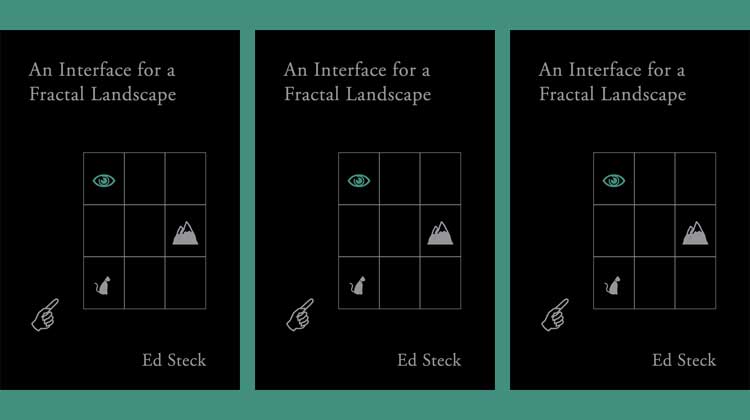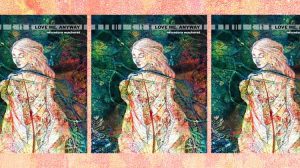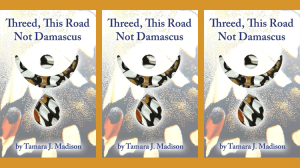An Interface for a Fractal Landscape by Ed Steck / Ugly Duckling Presse / 2019 / 978-1-946433-01-5 / 192 pages
 The corporeal and the digital are not mutually exclusive zones. Often they overlap. The latter mimicking the behavior of the former or vice versa. The programmed mutations of an organic substance. A procedurally generated landscape constructed from triangular faces. Jagged topographies decorated with low-poly textures. Memory caches scattered across its breadth. Ed Steck’s An Interface for a Fractal Landscape is a work of cybernetic literature. It is text formed from the data that has coagulated around the components of your computer. Samples of the semi-organic tissue smeared across each page.
The corporeal and the digital are not mutually exclusive zones. Often they overlap. The latter mimicking the behavior of the former or vice versa. The programmed mutations of an organic substance. A procedurally generated landscape constructed from triangular faces. Jagged topographies decorated with low-poly textures. Memory caches scattered across its breadth. Ed Steck’s An Interface for a Fractal Landscape is a work of cybernetic literature. It is text formed from the data that has coagulated around the components of your computer. Samples of the semi-organic tissue smeared across each page.
The book’s form operates within a set of diegetic constraints. Operating simultaneously as both text and paratext. Certain sections map out the circumstances surrounding and dictating the titular fractal landscape and the archival crawler units that traverse it. Handwritten notes mention simulated orange groves and disparate experiences derived from memory caches. Figures and diagrams play visual aid in the margins. Paratextual short stories and essays construct the history of terrain architects and their creations. Semi-coherent excerpts map the lived-experience of off-the-grid crawlers. World building occurs not only in the text itself, but in the form as well. Changes in font and structure create new perspectives. It is difficult to say what kind of book this is. It is not a novel or a poetry collection. It is something that exists in that ambiguous zone of text. Its genre is irreducible. One might think of it as data text. In which narrative threads are replaced with a wealth of information. There is not a singular predominant story to An Interface for a Fractal Landscape, instead there is a gauntlet of equally important texts ranging from the poetic to the theoretical. When assembled into one book, they become an extensive guide to the fractal landscape and the programs that inhabit its endless terrain.
The simulacrum in question is not a one-for-one recreation of our own. It is reminiscent of low-poly videogames. While reading, I was reminded of game environments like those in S.T.A.L.K.E.R. or Deus Ex. The uncanny landscapes of the 2000s. Flat surfaces and geometrically simplistic structures. 2D images painted onto the walls (one labeled “rock” another “swamp floor”). The sky a weak ceiling. Defunct technology prone to malfunction. Anomalies scattered across the terrain. Steck provides samples of various textures. Each intended to fill in one triangular face of the fractal landscape. Creating shorthand facsimiles of the physical plane. Archival crawler units seeing these unconvincing surfaces and taking them at face value.
In an unfamiliar digital zone, it is hard to understand the behaviors of an acclimated subject (whether crawler or terrain architect). This isn’t to say that their behaviors are unbelievable; often it is the contrary. In “Rockshelter,” a terrain architect’s account of his time in the fractal landscape, you get the sense that you are watching an expert at work. You are watching someone as they inspect their own work, hitting the run program button for the first time after a few integral modifications. In another section, “AN ARCHIVAL CRAWLER UNIT IN A FRACTAL LANDSCAPE” the crawler performs standard procedures and adapts to seemingly hopeless changes in its circumstances. There is internal discussion of what to do next and the sensations being felt after unexpected malfunctions. Descriptions of said malfunctions are always believable and terrifying, but they are equally uncanny and foreign. “The body of previous association is now an alien vessel.” In a world that you do not understand, rational decisions become enigmatic.
During a routine (whatever one might consider routine in an environment such as this) exploration of a fractal landscape, an archival crawler unit becomes detached from its simulated body. Typically operating from a third person perspective, the unit finds its virtual form slowly floating apart. Its kino-eye-view holding still as the vessel continues to move, performing the actions of the memory it has activated. A cat hovers into view. With detailed fur and complex textures; softness and comfort. The crawler unit finds relief in the blissful posturing of the virtual pet. As their body continues to float apart they find themselves in the strange position of feeling both extra-sensory yet detached. They are not their body, but they can feel what it feels. When the outlook becomes hopeless, the crawler marks the cat as a permanent feature of the landscape, ensuring that it will remain after they are gone. “Cat-to-landscape experience is raw data.” Their texture enters the generative forms of the environment. Cat-becoming-mountain. Cat-becoming-deciduous tree. They are integrated into their surroundings.
As the book moves through its various forms, its pace becomes rhythmic and cyclical. Each structure introduced, changed, and revisited. In a work of almost complete unfamiliarity, these recurring styles become a source of comfort. They convert this foreign environment into something with the potential to be understood. It engenders your learning. An Interface for a Fractal Landscape treats its reader as if they were a researcher. It collects each piece of media (essay, short story, program, handwritten notes, etc.) that might be deemed important in a newcomer’s understanding of this universe and presents it to them in one place. In the background, there is the spectre of investigation. As if these documents have been collected for some special purpose. As if it is your job to see the fractal landscape for what it truly is (the answer to which I am not sure that I have yet to reach).
At the same time that I am reminded of S.T.A.L.K.E.R. and Deus Ex, I am also reminded of Hypnospace Outlaw, in which the user is taught the functions of a non-existent operating system and shown how to navigate its labyrinthine structure / master its strange methods for navigation. Examining the various text-artifacts of this book, I feel as if I am being taught the means for interpreting this enigmatic zone. In the penultimate section, “DIGITAL NATURE COMMANDS” the behavior of the archival crawler units become empathetic and the strange program-oriented language of their environment becomes interpretable. Submerged in this new landscape, you begin to recognize certain terms when they appear and reappear in conversation. Mentions of textures and null functions reveal themselves as visual prompts. Records of successful and failed renders turn into maps. At the end of the data text, it feels as if the investigation is ready to begin. Your understanding of the vocabulary and procedures have become more complex and detailed. When I was done with An Interface for a Fractal Landscape, I felt like I was only half-finished. I felt the desire to reread passages / sections. I wanted to return to early moments that I had not fully understood / supplementary text that I didn’t have the full context for. The data of the data text is never complete. It is always footnoted by information you have yet to receive or interpret.
Steck’s An Interface for a Fractal Landscape is an innovative and engaging text. It is a physical work with the likeness of a digital entity. The raw data of a program and its read-me notes printed and bound. Out of the collected diagrams, nature commands, texture packs, terrain notes, the fractal landscape and its occupants emerge fully-formed. They slouch towards sentience, converting anomalous zones into something familiar and beautiful.





Leave a Reply